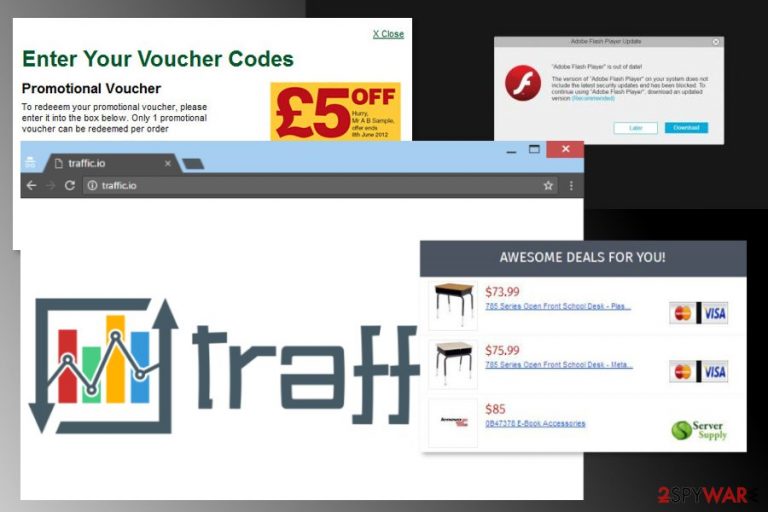Traffic Exchange ads (spam) - Jul 2021 update
Traffic Exchange ads Removal Guide
What is Traffic Exchange ads?
Traffic Exchange is a site that shows false advertisements and promotional content

Traffic Exchange is a platform used to deliver ads to internet users all over the world and reroute traffic to various websites. However, this service is known to cooperate with such shady ad-supported[1] applications like traffic.io or online.io.
Unfortunately, this collaboration is not good news for users, as they will suffer from constant redirects, pop-ups, banners, coupons, and other commercial content on Google Chrome, Internet Explorer, Mozilla Firefox, Safari, or another browser. Traffic Exchange ads may cover the content of sites that usually do not serve promotions, diminishing the web browsing experience significantly. More ever, users might end up with poorly monitored sites or even phishing or malware-laden domains that can compromise online safety.
| Name | Traffic Exchange |
| Type | Adware, potentially unwanted program |
| Distribution | Software bundling, unsafe websites |
| Main dangers | Malware infections, data leak |
| Affected browsers | Google Chrome, Internet Explorer, Mozilla Firefox, Safari, etc. |
| Elimination | Check our instructions below or rely on ant-malware tool that can detect the threat for you and terminate it fully |
| Optimization | Scan your device with FortectIntego for best results |
Traffic Exchange PUP spreads bundled with various free applications that users can download from torrents, P2P networks, or other freeware downloads sources. After successful infiltration, the questionable adware sets up a browser extension and tracking cookies[2] to spy on user’s activity online.
Typically, the intruder affects each web browser and collects the user’s search queries, clicks, and information such as what websites the user has visited, what is the geolocation of the affected computer, and IP address as well. Such information is useful for ad networks and commercial services just like the adware. Based on these details, the adware generates targeted advertisements that display catchy offers and lure the user to click on them.
Traffic Exchange ads interfere with the peace of the user’s mind by appearing in new browser tabs or windows or as banners placed on websites that the user visits. It is important to know that these ads do not originate from these sites and they appear only because of this adware program. It is highly NOT advisable to click on these ads because they can hide links leading to third-party websites that might be dangerous.
Some untrustworthy websites provide corrupted links or malware-laden ads[3] that can harm the computer as soon as the user clicks on them. You should not tolerate these redirect issues that might end up with ransomware attacks,[4] infiltration of the banking trojan, or sensitive data theft.
Although Traffic Exchange ads might not be marked with typical “powered by” or “brought to you by” markings, you can detect what program is sending these intrusive ads to you by running a system scan with reputable anti-spyware software like SpyHunter 5Combo Cleaner, Malwarebytes. You should run a full system scan with anti-malware as soon as you notice an increased amount of online ads popping up on the screen or your favorite websites.

Adware might sneak into the computer with the help of freeware
The adware spreads legitimately and can be installed with the user’s authorization only. People who get their machines infected with this ad-supported program typically are shocked to find that out because they have no idea when and how did such programs get inside their computers. To prevent the hijack, and as well stop other PUPs from affecting your computer, pay more attention to the information that software installation wizards provide.
Typically, installation wizards allow the user to choose preferred installation settings, and we highly recommend you to opt for the Custom or Advanced option. Either one or another option reveals all additional applications added to the primary program and allows the user to reject them. You are not going to be introduced to extra components if you decide to leave Standard or Default settings on – do not forget it!
Guidelines for the proper Traffic Exchange PUP removal
If you are looking for the manual Traffic Exchange removal guide, you can find it at the end of the article. However, before you go, we want to pay your attention to three main stages of the manual elimination:
- Uninstall suspicious programs, files, and other components from the system.
- Check browser extensions and remove unknown add-ons, extensions, or plugins.
- Reset each of the browsers installed on your PC.
If the ads come back or you want to speed up the virus removal process, you should obtain an anti-malware tool and remove Traffic Exchange with the help of it. Security experts from Hungary[5] remind us that having a security program installed helps to minimize the risk of adware attacks in the future.
You may remove virus damage with a help of FortectIntego. SpyHunter 5Combo Cleaner and Malwarebytes are recommended to detect potentially unwanted programs and viruses with all their files and registry entries that are related to them.
Getting rid of Traffic Exchange ads. Follow these steps
Uninstall from Windows
Instructions for Windows 10/8 machines:
- Enter Control Panel into Windows search box and hit Enter or click on the search result.
- Under Programs, select Uninstall a program.

- From the list, find the entry of the suspicious program.
- Right-click on the application and select Uninstall.
- If User Account Control shows up, click Yes.
- Wait till uninstallation process is complete and click OK.

If you are Windows 7/XP user, proceed with the following instructions:
- Click on Windows Start > Control Panel located on the right pane (if you are Windows XP user, click on Add/Remove Programs).
- In Control Panel, select Programs > Uninstall a program.

- Pick the unwanted application by clicking on it once.
- At the top, click Uninstall/Change.
- In the confirmation prompt, pick Yes.
- Click OK once the removal process is finished.
Delete from macOS
Remove items from Applications folder:
- From the menu bar, select Go > Applications.
- In the Applications folder, look for all related entries.
- Click on the app and drag it to Trash (or right-click and pick Move to Trash)

To fully remove an unwanted app, you need to access Application Support, LaunchAgents, and LaunchDaemons folders and delete relevant files:
- Select Go > Go to Folder.
- Enter /Library/Application Support and click Go or press Enter.
- In the Application Support folder, look for any dubious entries and then delete them.
- Now enter /Library/LaunchAgents and /Library/LaunchDaemons folders the same way and terminate all the related .plist files.

Remove from Microsoft Edge
Delete unwanted extensions from MS Edge:
- Select Menu (three horizontal dots at the top-right of the browser window) and pick Extensions.
- From the list, pick the extension and click on the Gear icon.
- Click on Uninstall at the bottom.

Clear cookies and other browser data:
- Click on the Menu (three horizontal dots at the top-right of the browser window) and select Privacy & security.
- Under Clear browsing data, pick Choose what to clear.
- Select everything (apart from passwords, although you might want to include Media licenses as well, if applicable) and click on Clear.

Restore new tab and homepage settings:
- Click the menu icon and choose Settings.
- Then find On startup section.
- Click Disable if you found any suspicious domain.
Reset MS Edge if the above steps did not work:
- Press on Ctrl + Shift + Esc to open Task Manager.
- Click on More details arrow at the bottom of the window.
- Select Details tab.
- Now scroll down and locate every entry with Microsoft Edge name in it. Right-click on each of them and select End Task to stop MS Edge from running.

If this solution failed to help you, you need to use an advanced Edge reset method. Note that you need to backup your data before proceeding.
- Find the following folder on your computer: C:\\Users\\%username%\\AppData\\Local\\Packages\\Microsoft.MicrosoftEdge_8wekyb3d8bbwe.
- Press Ctrl + A on your keyboard to select all folders.
- Right-click on them and pick Delete

- Now right-click on the Start button and pick Windows PowerShell (Admin).
- When the new window opens, copy and paste the following command, and then press Enter:
Get-AppXPackage -AllUsers -Name Microsoft.MicrosoftEdge | Foreach {Add-AppxPackage -DisableDevelopmentMode -Register “$($_.InstallLocation)\\AppXManifest.xml” -Verbose

Instructions for Chromium-based Edge
Delete extensions from MS Edge (Chromium):
- Open Edge and click select Settings > Extensions.
- Delete unwanted extensions by clicking Remove.

Clear cache and site data:
- Click on Menu and go to Settings.
- Select Privacy, search and services.
- Under Clear browsing data, pick Choose what to clear.
- Under Time range, pick All time.
- Select Clear now.

Reset Chromium-based MS Edge:
- Click on Menu and select Settings.
- On the left side, pick Reset settings.
- Select Restore settings to their default values.
- Confirm with Reset.

Remove from Mozilla Firefox (FF)
Remove dangerous extensions:
- Open Mozilla Firefox browser and click on the Menu (three horizontal lines at the top-right of the window).
- Select Add-ons.
- In here, select unwanted plugin and click Remove.

Reset the homepage:
- Click three horizontal lines at the top right corner to open the menu.
- Choose Options.
- Under Home options, enter your preferred site that will open every time you newly open the Mozilla Firefox.
Clear cookies and site data:
- Click Menu and pick Settings.
- Go to Privacy & Security section.
- Scroll down to locate Cookies and Site Data.
- Click on Clear Data…
- Select Cookies and Site Data, as well as Cached Web Content and press Clear.

Reset Mozilla Firefox
If clearing the browser as explained above did not help, reset Mozilla Firefox:
- Open Mozilla Firefox browser and click the Menu.
- Go to Help and then choose Troubleshooting Information.

- Under Give Firefox a tune up section, click on Refresh Firefox…
- Once the pop-up shows up, confirm the action by pressing on Refresh Firefox.

Remove from Google Chrome
Delete malicious extensions from Google Chrome:
- Open Google Chrome, click on the Menu (three vertical dots at the top-right corner) and select More tools > Extensions.
- In the newly opened window, you will see all the installed extensions. Uninstall all the suspicious plugins that might be related to the unwanted program by clicking Remove.

Clear cache and web data from Chrome:
- Click on Menu and pick Settings.
- Under Privacy and security, select Clear browsing data.
- Select Browsing history, Cookies and other site data, as well as Cached images and files.
- Click Clear data.

Change your homepage:
- Click menu and choose Settings.
- Look for a suspicious site in the On startup section.
- Click on Open a specific or set of pages and click on three dots to find the Remove option.
Reset Google Chrome:
If the previous methods did not help you, reset Google Chrome to eliminate all the unwanted components:
- Click on Menu and select Settings.
- In the Settings, scroll down and click Advanced.
- Scroll down and locate Reset and clean up section.
- Now click Restore settings to their original defaults.
- Confirm with Reset settings.

Delete from Safari
Remove unwanted extensions from Safari:
- Click Safari > Preferences…
- In the new window, pick Extensions.
- Select the unwanted extension and select Uninstall.

Clear cookies and other website data from Safari:
- Click Safari > Clear History…
- From the drop-down menu under Clear, pick all history.
- Confirm with Clear History.

Reset Safari if the above-mentioned steps did not help you:
- Click Safari > Preferences…
- Go to Advanced tab.
- Tick the Show Develop menu in menu bar.
- From the menu bar, click Develop, and then select Empty Caches.

After uninstalling this potentially unwanted program (PUP) and fixing each of your web browsers, we recommend you to scan your PC system with a reputable anti-spyware. This will help you to get rid of Traffic Exchange registry traces and will also identify related parasites or possible malware infections on your computer. For that you can use our top-rated malware remover: FortectIntego, SpyHunter 5Combo Cleaner or Malwarebytes.
How to prevent from getting adware
Do not let government spy on you
The government has many issues in regards to tracking users' data and spying on citizens, so you should take this into consideration and learn more about shady information gathering practices. Avoid any unwanted government tracking or spying by going totally anonymous on the internet.
You can choose a different location when you go online and access any material you want without particular content restrictions. You can easily enjoy internet connection without any risks of being hacked by using Private Internet Access VPN.
Control the information that can be accessed by government any other unwanted party and surf online without being spied on. Even if you are not involved in illegal activities or trust your selection of services, platforms, be suspicious for your own security and take precautionary measures by using the VPN service.
Backup files for the later use, in case of the malware attack
Computer users can suffer from data losses due to cyber infections or their own faulty doings. Ransomware can encrypt and hold files hostage, while unforeseen power cuts might cause a loss of important documents. If you have proper up-to-date backups, you can easily recover after such an incident and get back to work. It is also equally important to update backups on a regular basis so that the newest information remains intact – you can set this process to be performed automatically.
When you have the previous version of every important document or project you can avoid frustration and breakdowns. It comes in handy when malware strikes out of nowhere. Use Data Recovery Pro for the data restoration process.
- ^ Adware. Wikipedia. The free encyclopedia.
- ^ Fact and Fiction: The Truth About Browser Cookies. Lifehacker. Tips, tricks and downloads for getting things done.
- ^ Noah Gamer. Ads on websites are dangerous to more than your sanity. Trend Micro Blogs. Security news, views and opinions .
- ^ Mathew J. Schwartz. Ransomware Attacks Subvert Ad Networks. BankInfoSecurity. Bank information security news, training, education.
- ^ Avirus. Avirus. Latest malware and cyber security news from Hungary.
